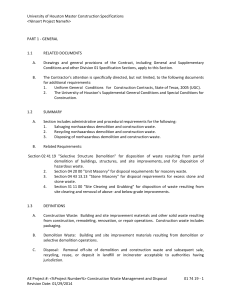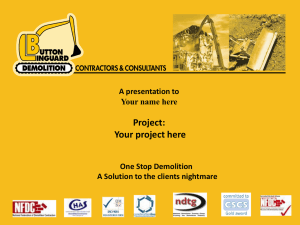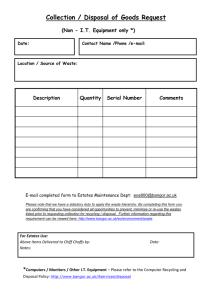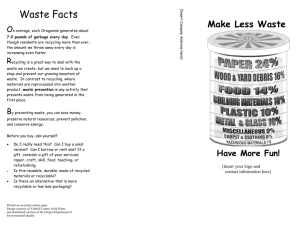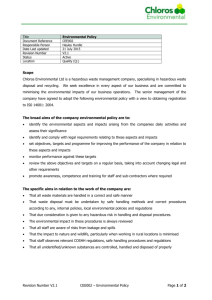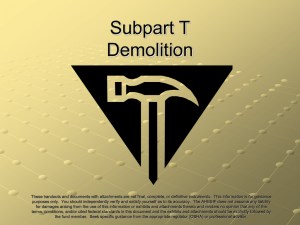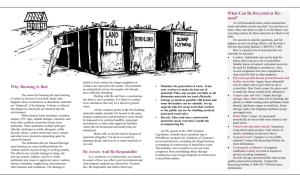01524-00 construction waste management and disposal
advertisement
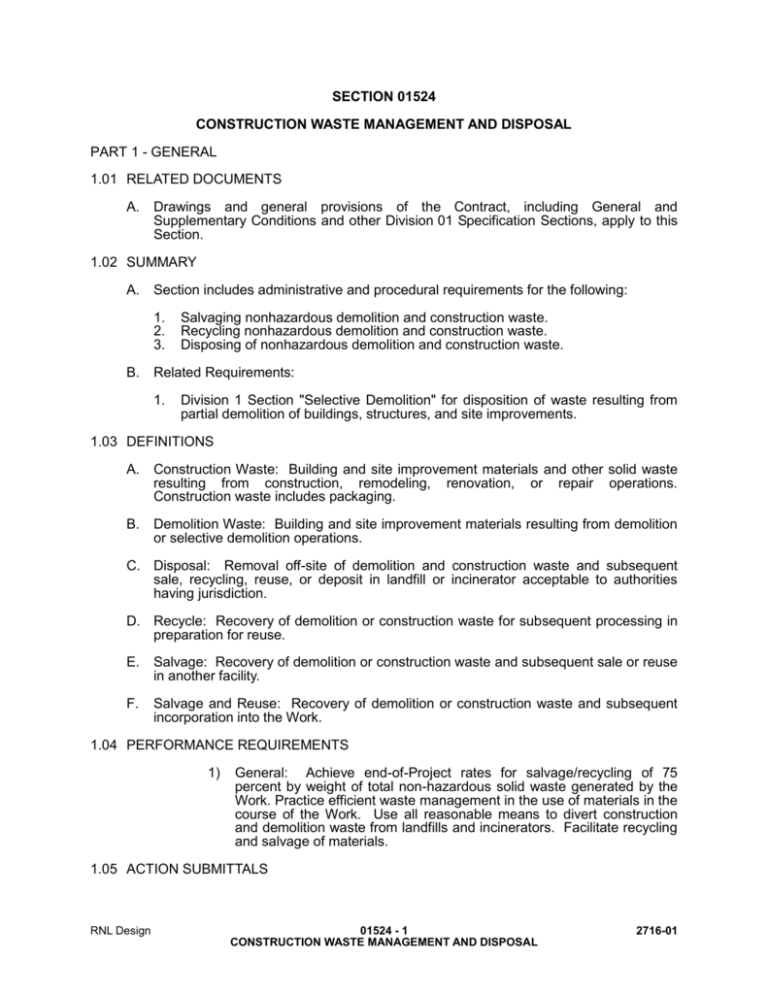
SECTION 01524 CONSTRUCTION WASTE MANAGEMENT AND DISPOSAL PART 1 - GENERAL 1.01 RELATED DOCUMENTS A. Drawings and general provisions of the Contract, including General and Supplementary Conditions and other Division 01 Specification Sections, apply to this Section. 1.02 SUMMARY A. Section includes administrative and procedural requirements for the following: 1. 2. 3. B. Salvaging nonhazardous demolition and construction waste. Recycling nonhazardous demolition and construction waste. Disposing of nonhazardous demolition and construction waste. Related Requirements: 1. Division 1 Section "Selective Demolition" for disposition of waste resulting from partial demolition of buildings, structures, and site improvements. 1.03 DEFINITIONS A. Construction Waste: Building and site improvement materials and other solid waste resulting from construction, remodeling, renovation, or repair operations. Construction waste includes packaging. B. Demolition Waste: Building and site improvement materials resulting from demolition or selective demolition operations. C. Disposal: Removal off-site of demolition and construction waste and subsequent sale, recycling, reuse, or deposit in landfill or incinerator acceptable to authorities having jurisdiction. D. Recycle: Recovery of demolition or construction waste for subsequent processing in preparation for reuse. E. Salvage: Recovery of demolition or construction waste and subsequent sale or reuse in another facility. F. Salvage and Reuse: Recovery of demolition or construction waste and subsequent incorporation into the Work. 1.04 PERFORMANCE REQUIREMENTS 1) General: Achieve end-of-Project rates for salvage/recycling of 75 percent by weight of total non-hazardous solid waste generated by the Work. Practice efficient waste management in the use of materials in the course of the Work. Use all reasonable means to divert construction and demolition waste from landfills and incinerators. Facilitate recycling and salvage of materials. 1.05 ACTION SUBMITTALS RNL Design 01524 - 1 CONSTRUCTION WASTE MANAGEMENT AND DISPOSAL 2716-01 A. Waste Management Plan: Submit plan within 7 days of date established for the Notice to Proceed. 1.06 INFORMATIONAL SUBMITTALS A. Waste Reduction Progress Reports: Concurrent with each Application for Payment, submit report. Use Form CWM-7 for construction waste and Form CWM-8 for demolition waste. Include the following information: 1. 2. 3. 4. 5. 6. 7. B. Material category. Generation point of waste. Total quantity of waste in tons. Quantity of waste salvaged, both estimated and actual in tons. Quantity of waste recycled, both estimated and actual in tons. Total quantity of waste recovered (salvaged plus recycled) in tons. Total quantity of waste recovered (salvaged plus recycled) as a percentage of total waste. Waste Reduction Calculations: Before request for Substantial Completion, submit calculated end-of-Project rates for salvage, recycling, and disposal as a percentage of total waste generated by the Work. C. Records of Donations: Indicate receipt and acceptance of salvageable waste donated to individuals and organizations. Indicate whether organization is tax exempt. D. Records of Sales: Indicate receipt and acceptance of salvageable waste sold to individuals and organizations. Indicate whether organization is tax exempt. E. Recycling and Processing Facility Records: Indicate receipt and acceptance of recyclable waste by recycling and processing facilities licensed to accept them. Include manifests, weight tickets, receipts, and invoices. F. Landfill and Incinerator Disposal Records: Indicate receipt and acceptance of waste by landfills and incinerator facilities licensed to accept them. Include manifests, weight tickets, receipts, and invoices. G. LEED Submittal: LEED letter template for Credit MR 2, signed by Contractor, tabulating total waste material, quantities diverted and means by which it is diverted, and statement that requirements for the credit have been met. H. Qualification Data: For refrigerant recovery technician. I. Statement of Refrigerant Recovery: Signed by refrigerant recovery technician responsible for recovering refrigerant, stating that all refrigerant that was present was recovered and that recovery was performed according to EPA regulations. Include name and address of technician and date refrigerant was recovered. 1.07 QUALITY ASSURANCE A. Refrigerant Recovery Technician Qualifications: certification program. B. Regulatory Requirements: Comply with hauling and disposal regulations of authorities having jurisdiction. RNL Design Certified by EPA-approved 01524 - 2 CONSTRUCTION WASTE MANAGEMENT AND DISPOSAL 2716-01 C. Waste Management Conference: Conduct conference at Project site to comply with requirements in Section 01 31 00 "Project Management and Coordination." Review methods and procedures related to waste management including, but not limited to, the following: 1. 2. 3. 4. 5. Review and discuss waste management plan including responsibilities of waste management coordinator. Review requirements for documenting quantities of each type of waste and its disposition. Review and finalize procedures for materials separation and verify availability of containers and bins needed to avoid delays. Review procedures for periodic waste collection and transportation to recycling and disposal facilities. Review waste management requirements for each trade. 1.08 WASTE MANAGEMENT PLAN A. General: Develop a waste management plan according to ASTM E 1609 and requirements in this Section. Plan shall consist of waste identification, waste reduction work plan, and cost/revenue analysis. Distinguish between demolition and construction waste. Indicate quantities by weight or volume, but use same units of measure throughout waste management plan. B. Waste Identification: Indicate anticipated types and quantities of demolition and construction waste generated by the Work. Use Form CWM-1 for construction waste and Form CWM-2 for demolition waste. Include estimated quantities and assumptions for estimates. C. Waste Reduction Work Plan: List each type of waste and whether it will be salvaged, recycled, or disposed of in landfill or incinerator. Use Form CWM-3 for construction waste and Form CWM-4 for demolition waste. Include points of waste generation, total quantity of each type of waste, quantity for each means of recovery, and handling and transportation procedures. 1. 2. 3. 4. 5. 6. Salvaged Materials for Reuse: For materials that will be salvaged and reused in this Project, describe methods for preparing salvaged materials before incorporation into the Work. Salvaged Materials for Sale: For materials that will be sold to individuals and organizations, include list of their names, addresses, and telephone numbers. Salvaged Materials for Donation: For materials that will be donated to individuals and organizations, include list of their names, addresses, and telephone numbers. Recycled Materials: Include list of local receivers and processors and type of recycled materials each will accept. Include names, addresses, and telephone numbers. Disposed Materials: Indicate how and where materials will be disposed of. Include name, address, and telephone number of each landfill and incinerator facility. Handling and Transportation Procedures: Include method that will be used for separating recyclable waste including sizes of containers, container labeling, and designated location where materials separation will be performed. D. Cost/Revenue Analysis: Indicate total cost of waste disposal as if there was no waste management plan and net additional cost or net savings resulting from implementing waste management plan. Use Form CWM-5 for construction waste and Form CWM6 for demolition waste. Include the following: 1. RNL Design Total quantity of waste. 01524 - 3 CONSTRUCTION WASTE MANAGEMENT AND DISPOSAL 2716-01 2. 3. 4. 5. 6. 7. 8. 9. Estimated cost of disposal (cost per unit). Include hauling and tipping fees and cost of collection containers for each type of waste. Total cost of disposal (with no waste management). Revenue from salvaged materials. Revenue from recycled materials. Savings in hauling and tipping fees by donating materials. Savings in hauling and tipping fees that are avoided. Handling and transportation costs. Include cost of collection containers for each type of waste. Net additional cost or net savings from waste management plan. PART 2 - PRODUCTS (Not Used) PART 3 - EXECUTION 3.01 PLAN IMPLEMENTATION A. General: Implement approved waste management plan. Provide handling, containers, storage, signage, transportation, and other items as required to implement waste management plan during the entire duration of the Contract. 1. B. Comply with operation, termination, and removal Section 01 50 00 "Temporary Facilities and Controls." requirements in Training: Train workers, subcontractors, and suppliers on proper waste management procedures, as appropriate for the Work. 1. 2. Distribute waste management plan to everyone concerned within three days of submittal return. Distribute waste management plan to entities when they first begin work on-site. Review plan procedures and locations established for salvage, recycling, and disposal. C. Site Access and Temporary Controls: Conduct waste management operations to ensure minimum interference with roads, streets, walks, walkways, and other adjacent occupied and used facilities. 1. 2. Designate and label specific areas on Project site necessary for separating materials that are to be salvaged, recycled, reused, donated, and sold. Comply with Section 01 50 00 "Temporary Facilities and Controls" for controlling dust and dirt, environmental protection, and noise control. 3.02 SALVAGING DEMOLITION WASTE A. Salvaged Items for Reuse in the Work: follows: 1. 2. 3. 4. 5. RNL Design Salvage items for reuse and handle as Clean salvaged items. Pack or crate items after cleaning. Identify contents of containers with label indicating elements, date of removal, quantity, and location where removed. Store items in a secure area until installation. Protect items from damage during transport and storage. Install salvaged items to comply with installation requirements for new materials and equipment. Provide connections, supports, and miscellaneous materials necessary to make items functional for use indicated. 01524 - 4 CONSTRUCTION WASTE MANAGEMENT AND DISPOSAL 2716-01 B. Salvaged Items for Sale and Donation: Not permitted on Project site. C. Salvaged Items for Owner's Use: Salvage items for Owner's use and handle as follows: 1. 2. 3. 4. 5. Clean salvaged items. Pack or crate items after cleaning. Identify contents of containers with label indicating elements, date of removal, quantity, and location where removed. Store items in a secure area until delivery to Owner. Transport items to Owner's storage area designated by Owner. Protect items from damage during transport and storage. D. Doors and Hardware: Brace open end of door frames. Except for removing door closers, leave door hardware attached to doors. E. Equipment: Drain tanks, piping, and fixtures. Seal openings with caps or plugs. Protect equipment from exposure to weather. F. Plumbing Fixtures: Separate by type and size. G. Lighting Fixtures: Separate lamps by type and protect from breakage. H. Electrical Devices: Separate switches, receptacles, switchgear, transformers, meters, panelboards, circuit breakers, and other devices by type. 3.03 RECYCLING DEMOLITION AND CONSTRUCTION WASTE, GENERAL A. General: Recycle paper and beverage containers used by on-site workers. B. Recycling Receivers and Processors: List below is provided for information only; available recycling receivers and processors include, but are not limited to, the following: 1. <Insert names and telephone numbers of local recycling receivers and processors of recyclable materials>. C. Recycling Incentives: Revenues, savings, rebates, tax credits, and other incentives received for recycling waste materials shall be shared equally by Owner and Contractor. D. Preparation of Waste: Prepare and maintain recyclable waste materials according to recycling or reuse facility requirements. Maintain materials free of dirt, adhesives, solvents, petroleum contamination, and other substances deleterious to the recycling process. E. Procedures: Separate recyclable waste from other waste materials, trash, and debris. Separate recyclable waste by type at Project site to the maximum extent practical according to approved construction waste management plan. 1. Provide appropriately marked containers or bins for controlling recyclable waste until removed from Project site. Include list of acceptable and unacceptable materials at each container and bin. a. 2. RNL Design Inspect containers and bins for contamination and remove contaminated materials if found. Stockpile processed materials on-site without intermixing with other materials. Place, grade, and shape stockpiles to drain surface water. Cover to prevent 01524 - 5 CONSTRUCTION WASTE MANAGEMENT AND DISPOSAL 2716-01 3. 4. 5. windblown dust. Stockpile materials away from construction area. Do not store within drip line of remaining trees. Store components off the ground and protect from the weather. Remove recyclable waste from Owner's property and transport to recycling receiver or processor. 3.04 RECYCLING DEMOLITION WASTE A. Asphalt Paving: Break up and transport paving to asphalt-recycling facility. B. Concrete: Remove reinforcement and other metals from concrete and sort with other metals. 1. Pulverize concrete to maximum [1-1/2-inch] [4-inch] size. C. Masonry: Remove metal reinforcement, anchors, and ties from masonry and sort with other metals. 1. Pulverize masonry to maximum [3/4-inch] [1-inch] [1-1/2-inch] [4-inch] size. a. b. 2. Crush masonry and screen to comply with requirements in Section 31 20 00 "Earth Moving" for use as [general fill] [satisfactory soil for fill or subbase]. Crush masonry and screen to comply with requirements in Section 32 93 00 "Plants" for use as mineral mulch. Clean and stack undamaged, whole masonry units on wood pallets. D. Wood Materials: Sort and stack members according to size, type, and length. Separate lumber, engineered wood products, panel products, and treated wood materials. E. Metals: Separate metals by type. 1. 2. F. Structural Steel: Stack members according to size, type of member, and length. Remove and dispose of bolts, nuts, washers, and other rough hardware. Asphalt Shingle Roofing: Separate organic and glass-fiber asphalt shingles and felts. Remove and dispose of nails, staples, and accessories. G. Gypsum Board: Stack large clean pieces on wood pallets or in container and store in a dry location. Remove edge trim and sort with other metals. Remove and dispose of fasteners. H. Acoustical Ceiling Panels and Tile: Stack large clean pieces on wood pallets and store in a dry location. I. Metal Suspension System: Separate metal members including trim, and other metals from acoustical panels and tile and sort with other metals. J. Carpet: Roll large pieces tightly after removing debris, trash, adhesive, and tack strips. 1. K. RNL Design Store clean, dry carpet in a closed container or trailer provided by Carpet Reclamation Agency or carpet recycler. Carpet Tile: Remove debris, trash, and adhesive. 01524 - 6 CONSTRUCTION WASTE MANAGEMENT AND DISPOSAL 2716-01 1. L. Stack tile on pallet and store clean, dry carpet in a closed container or trailer provided by Carpet Reclamation Agency or carpet recycler. Piping: Reduce piping to straight lengths and store by type and size. Separate supports, hangers, valves, sprinklers, and other components by type and size. M. Conduit: Reduce conduit to straight lengths and store by type and size. 3.05 RECYCLING CONSTRUCTION WASTE A. Packaging: 1. 2. 3. 4. B. Cardboard and Boxes: Break down packaging into flat sheets. Bundle and store in a dry location. Polystyrene Packaging: Separate and bag materials. Pallets: As much as possible, require deliveries using pallets to remove pallets from Project site. For pallets that remain on-site, break down pallets into component wood pieces and comply with requirements for recycling wood. Crates: Break down crates into component wood pieces and comply with requirements for recycling wood. Wood Materials: 1. 2. Clean Cut-Offs of Lumber: Grind or chip into small pieces. Clean Sawdust: Bag sawdust that does not contain painted or treated wood. a. Comply with requirements in Section 32 93 00 "Plants" for use of clean sawdust as organic mulch. C. Gypsum Board: Stack large clean pieces on wood pallets or in container and store in a dry location. 1. Clean Gypsum Board: Grind scraps of clean gypsum board using small mobile chipper or hammer mill. Screen out paper after grinding. a. Comply with requirements in Section 32 93 00 "Plants" for use of clean ground gypsum board as inorganic soil amendment. 3.06 DISPOSAL OF WASTE A. General: Except for items or materials to be salvaged, recycled, or otherwise reused, remove waste materials from Project site and legally dispose of them in a landfill or incinerator acceptable to authorities having jurisdiction. 1. 2. B. Except as otherwise specified, do not allow waste materials that are to be disposed of accumulate on-site. Remove and transport debris in a manner that will prevent spillage on adjacent surfaces and areas. Burning: Do not burn waste materials. C. Burning: Burning of waste materials is permitted only at designated areas on Owner's property, provided required permits are obtained. Provide full-time monitoring for burning materials until fires are extinguished. D. Disposal: Remove waste materials and dispose of at designated spoil areas on Owner's property. RNL Design 01524 - 7 CONSTRUCTION WASTE MANAGEMENT AND DISPOSAL 2716-01 E. Disposal: Remove waste materials from Owner's property and legally dispose of them. 3.07 ATTACHMENTS A. Form CWM-1 for construction waste identification. B. Form CWM-2 for demolition waste identification. C. Form CWM-3 for construction waste reduction work plan. D. Form CWM-4 for demolition waste reduction work plan. E. Form CWM-5 cost/revenue analysis of construction waste reduction work plan. F. Form CWM-6 cost/revenue analysis of demolition waste reduction work plan. G. Form CWM-7 for construction waste H. Form CWM-8 for demolition waste. END OF SECTION 01524 RNL Design 01524 - 8 CONSTRUCTION WASTE MANAGEMENT AND DISPOSAL 2716-01


